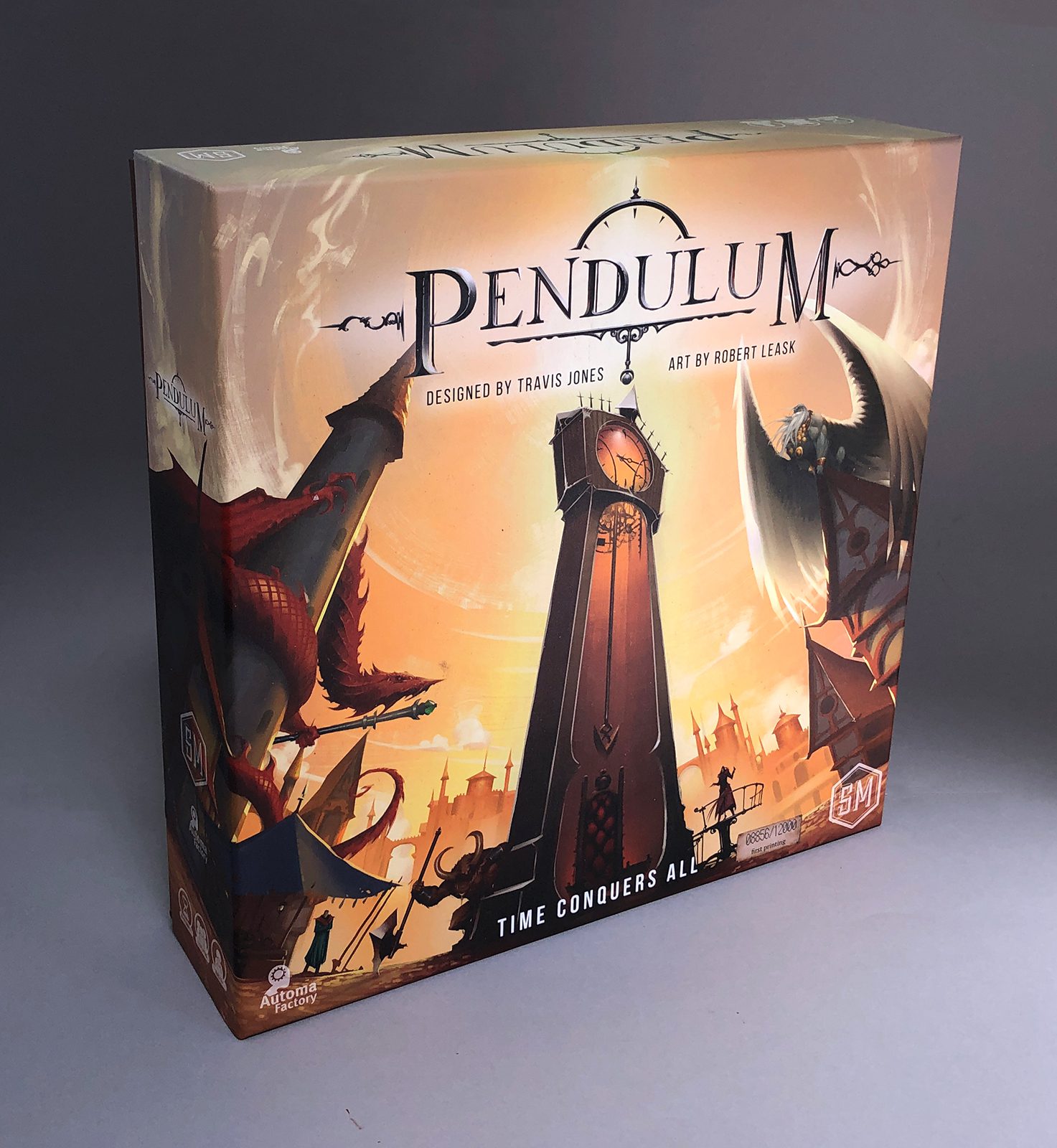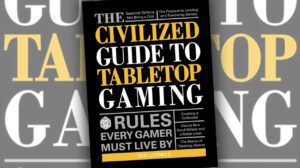Time Is Ahead of Us
There are books where the setting is just as important and as distinctive as the individual characters themselves. Consider Hogwarts. The School of Witchcraft and Wizardry, with its ever-moving staircases, common rooms, ghosts and talking portraits, is such an integral part of the story that a theme park franchise built a pair of them—one on each US coast—for tourists to visit.
It’s rare that a gaming mechanism rises to this level, but I believe that games that incorporate a Real Time element to them do just this.
My first encounter with a Real Time board game was with TAMSK, the now sadly orphaned game from Kris Burm‘s Project GIFP series. In TAMSK, players’ game pieces are sandglass timers that must be constantly turned over to stay active. If the sand runs out, that piece is frozen on the board, limiting your movements and denoting a loss of potential scoring points.
TAMSK is the only game I play standing up. There’s so much going on so quickly that I’m afraid if I stay seated, I’m going to miss something. Personally, TAMSK is one of my favorite games, period. Having Time as an essential mechanic of the game made it a lone standout in my collection.
Until Pendulum.

In Pendulum there are three sets of sandglass timers that rule over their own distinct areas of the game board, dictating where players can place meeples, when actions can be taken, and where you are in the phases of the game. On top of that, players can choose how quickly they flip those timers once the sand runs out, including turning one over before another player has claimed an action.
Okay—before I get any further ahead of myself, let’s stop here and I’ll give you an overview of how Pendulum works.
Time After Time
In the bottom right corner of the Pendulum board is a marker to indicate the player count. The differences are minor, but 1-3 players get one side; 4-5 players get the other.

Players either choose or are randomly given one of five characters to play during the game. In your first games, there will be relatively minor differences between the characters.

Each player receives ten cubes each of red, blue and yellow, along with ten square lavender squares. They’ll also receive three small (Common) meeples and two large (Grande) meeples.
Individual player mats will indicate the number for Military (red), Culture (blue), and Gold (yellow) cubes players will start with as well as how many Votes (lavender squares). Each player will always start with one Common (small) Worker and one Grande (large) meeple, with another two Common and one Grande meeple set aside for now.
Along the top edge of your player mat are the four scoring tokens, Power (red), Prestige (blue), Popularity (yellow), and gray. The scoring track is divided by a line, with the right side of the line being a lighter color. You’ll need to take the proper actions throughout the game to move your scoring markers to the right. Only markers that get moved into the parchment-colored area score. Be the player with your tokens moved furthest to the right at the end of the game and you’ll win.
And that gray marker? Oh, we’ll come back to it.
Let’s Do the Time Warp Again
At the bottom of the player board are four areas, each with a colored background to their banners. When you take the action corresponding to these areas on the game board, you’ll collect the benefit listed on the player mat: brown allows you to move up one on the red track at the top of your player board; red gains you four Military (red cubes); purple gets you five Culture (blue cubes); yellow gets you two Gold (yellow cubes).
You will, of course, need all of these, repeatedly, throughout the game.

Each player will receive four cards. Three of these cards will be identical for all players: Move up one on the Prestige (blue) Victory track; gain one resource of your choice; take one of your workers from an area it’s trapped in (more on this later). The fourth allows you to gain an additional Common Worker, the conditions for which will be different for each player.
Note: Grande workers can be placed anywhere on the board; Common workers must be placed in an area first or choose another action space to take.
As Time Goes By
The board is divided into five distinct area. The three playing sections are:
- The black section where you can take the Yellow action on your player mat, gain one Vote, pay four Military for a Province, or take one resource of your choice.
- The green section where players can pay two Gold to: move up one on their red track and gain two votes, move up two on their yellow track, or take the red action on their player mat.
- The purple section where players may spend two Gold to take the purple action on their player mat, move up one on the yellow and blue tracks and take a single vote, or take the brown action on their player mat.
Each section is divided into an upper and lower section that is a duplicate of each other. The reasons for this will become clear as we go on.
In the lower left corner of the board are the Provinces. Four Provinces are placed, face-up, at the start of the game.
In the Black section, a player can trade in four Military to ‘conquer’ a Province. The conquering player chooses a Province and chooses the banner color/benefit and slides it under their player mat.
Province cards are square, with one of the four banners from your player board along one edge. On a Province’s banner is an additional benefit for that banner type.

Tucked Provinces become part of your permanent player mat, thus allowing you to do a bit of engine-building. You can add as many Provinces to your player mat during a round as you’d like, but you’ll have to discard down to two per banner at the end of a round.
Time, He’s Waiting in the Wings

Between the purple and green sections is a red area with the Achievement cards. One card will be turned over per round. You’ll need to pay attention to the conditions on the Achievement card because being the first one to meet them during one of the four rounds is the only way you’re going to gain the Legendary Achievement status.

Remember that lone, gray marker at the top of your player mat? That indicates your Legendary Achievement status. The only way to move it into the parchment area is to be the first player in a round to meet the conditions on an Achievement card.
Here’s the catch with this one: you cannot win the game if you haven’t moved your Legendary Status marker to the right.
It’s the Time of the Season
Four times during the game, play will stop and it will be time to Call Council. The Council Phase starts with players tallying the Votes they collected during the round. The hexagonal markers above the Achievement cards are placed in top-down order to reflect this order. (In an interesting twist, if players are tied, their current order is reversed on this track.)
Votes matter because at the end of each round, players will gain bonuses. As printed on the board, whoever comes in first will can move up one space on two of their player mat victory tracks (or two on a single track). Second place may move up one on a single track. Third place and later get no victory track bonuses.
As well, in Vote order, players may choose from the Council Bonus cards available that round. Those with lightning bolts in the upper left corner are one-time bonuses that must be taken immediately. Cards with a Sun icon get added to the player’s deck of cards to be used throughout the rest of the game.
After all players have selected a bonus card, clear the bonus cards (save for the Grande Worker card) and replace them with new cards. As well, remove all the face-up Province cards and replace them with new Provinces. Remove all of your Votes from your player board. Set out a new Achievement card, and the next round is ready to begin.
The Times They Are A Changin’
“Hey, waitaminute,” I can hear you say. “What about all of that Hogwarts nonsense at the start of all this?”
Good to know you were paying attention.
Thus far, Pendulum sounds like a fairly common worker placement game: place a worker, take an action, gain some resources, score some points. Here’s where things take a very unique twist.

Each of the three playing sections have areas to their side with round, gold-framed markers. The black and green have two, the purple has four. Start by placing each of the sand timers in the upper section of their colored area.

Workers cannot be placed in any of the playable areas alongside a timer. Instead, they can only be placed in the action areas of the row where the timer is not.
However, unlike many worker placement games, workers cannot immediately take the chosen action. Instead, they must wait until the sand timer flips from the other area into the gold circle alongside their chosen actions. At that point, players can move their workers down (paying two gold for the purple and green actions) and then take the action shown in the bottom area.

And then…they wait. Until the sand runs out before they can reclaim and move the worker.
Time Waits for No One and It Won’t Wait for Me
When the sand runs out on a given timer, any player can then flip the timer to the other golden circle in its section. Only then can players remove workers from that action area and place it elsewhere on the board—to an action area that does not have a sand timer next to it.
Think of it this way: workers can move into an action space only when the sand timer isn’t watching. However, it can only take the action when the timer is watching. Then, it must wait until the timer has left before moving to another action space.
Looking at the actions available in each section, you can see that the purple area actions are really good. The green actions are good, and the black area actions are each helpful. The relative strength of these areas is reflected in the amount of time it takes for each sand timer to run out: Black takes 45 seconds, Green 2 minutes, and Purple takes 3 minute.
Who Knows Where the Time Goes?
If all of that sounds a bit intimidating, (and it should) the designers included a great teaching aid: the Timer Track.

For your first game it is recommended that you play with the Timer Track. While you’ll still turn the sand timers over, you won’t be governed by the sand running through them. Instead, you’ll move an hourglass token down the Timer Track and flipping the marked sand timers. All players can then take their actions at a leisurely pace. Once everyone has agreed they’re set, the hourglass marker is moved down to the next step on the Timer Track and the corresponding sand timers are flipped over.
We played our first game of Pendulum with the Timer Track and it definitely helped us learn the basics of the game. However, by the end of the game we were all pretty meh about it. When I convinced my group to give it another try, we played the first round with the Timer Track to get back into the feel of the game.
Then we set it aside and just played with the sand timers properly.
What a difference.
Time Is (Not) On Your Side
There are no turns in the traditional sense in Pendulum. Players place workers across the board at the same time, as well as move their workers down into the playable areas and take the applicable actions as the sand timers are turned over.
This means there is a sense of vaguely controlled chaos going on with the common playing board followed by time where each player is playing an intensely personal game on their own player board. It’s a really fascinating mix of tangential interaction and having neither the time or mental bandwidth to watch what anyone else is doing.
Outside of my own player board, the only other thing I’ve been able to give any attention to was the sand timers.
There is also no requirement that someone must turn over a sand timer when the sand has run out. If you don’t have a worker in that area, you can let someone else worry about it. As well, there’s nothing that says a player must tell the other players they’re turning over a sand timer. That worker whose action you took on the active row and then forgot to move? It’s now stuck there until the timer moves again. (And, no, you cannot take the action again.)
Watchin’ the Time Roll Away
After finishing our first game with the sand timers we each needed a moment or two to catch our breath.
We all agreed we had played a really good, tense game that kept us mentally alert and physically agile.
We also agreed that we had no interest in ever going back to the Timer Track way of playing again.
It’s Just That the Time Was Wrong
As much as I like Pendulum, there are some things about the game that need serious improvement.The player mats are flat boards. They need to have recessed areas for each of the scoring markers. Given the sometimes frantic movements when moving workers, collecting and spending resources, and turning sand timers, we have yet to play a game of Pendulum where our scoring markers haven’t been bumped off track.
I’ve read somewhere Stonemeier went with flat, textured mats so he could have two-sided boards, with an Advanced version of the characters on the other side. While I get this, the board is still just unacceptable in my mind. (It might even be a worse offender than Terraforming Mars.)
In some of the first run printings there were complaints that some of the sand timers got stuck. Not good. It’s hard to play a sand timer-driven game when the sand doesn’t flow properly. We had this happen to us once when the Green sand timer got stuck and no one noticed it for a while. We all agreed to tap the timer on the table before setting them in place on the board, which seemed to have resolved the issue.
Closing Time
Back in 1975 the psychologist Mihály Csíkszentmihályi coined the phrase flow to describe
“… the mental state in which a person performing some activity is fully immersed in a feeling of energized focus, full involvement, and enjoyment in the process of the activity. In essence, flow is characterized by the complete absorption in what one does, and a resulting transformation in one’s sense of time.”
As a writer, I’ve experienced flow in the writing process only a few, rare times. As a gamer, TAMSK was the closest I’d ever gotten to flow in a board game.
Until Pendulum.
Played with the sand timers, Pendulum is all flow. Your mind and hands are constantly moving, trying to make the best decisions. Workers are placed, timers get flipped, actions are taken, resources traded for Provinces or points.
I realize this might be a complete turn-off for some people. (To be fair, I have a gaming friend who hates TAMSK. He plays board games to relax and after playing TAMSK once he said he never wanted to play it again.) After all, Pendulum is never going to be considered a relaxing game in the way Cascadia and So Clover are.
And yet…
There was something about that flow state that I love. I found myself letting go of the Absolute Need to Make Exactly the Correct Decision at Exactly the Right Moment and just go with the game. I knew what needed to be done and had an idea on how to get it done. I tried my best to approach The Inner Game of Pendulum. And while it was intensely engaging, I did find my own comfortable rhythm within the game.
And that is a very rare feeling when playing any game.
Pendulum is a game I’ll share with serious gamers looking for something different, something unique. If that sounds like you, I think you owe it to yourself to give it a few plays. It’s definitely worth your time.












Add Comment